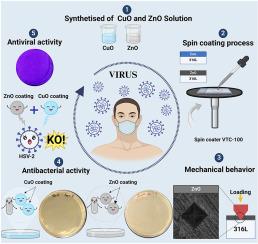用于抗菌和抗病毒的氧化锌和氧化铜涂层的合成与表征
IF 4.3
3区 材料科学
Q2 MATERIALS SCIENCE, MULTIDISCIPLINARY
引用次数: 0
摘要
氧化铜(CuO)和氧化锌(ZnO)涂层因其潜在的抗病毒特性(包括抗病毒能力)而备受关注。本研究的重点是开发和表征利用旋涂技术获得的由氧化铜和氧化锌组成的自消毒表面钝化膜。该研究旨在开发能主动消除有害微生物、降低感染风险的表面,同时还能提供强大的机械阻力和附着力,以抵御外部因素的影响,这对于确保长期有效性至关重要。此外,还使用 SEM/EDS(即扫描电子显微镜/能量色散 X 射线光谱和 X 射线衍射分析 (XRD))分析了精心制作的薄膜的微观结构特性。机械性能通过维氏硬度和抗划痕测试进行评估。结果发现薄膜致密且均匀。氧化铜和氧化锌薄膜的硬度分别为 11.14 ± 0.04 GPa 和 8.89 ± 0.04 GPa。因此,划痕测试表明 CuO 和 ZnO 薄膜具有很高的附着力,临界载荷 LC1 分别为 1.89 ± 0.02 N 和 1.04 ± 0.02 N。研究还发现,CuO 和 ZnO 薄膜对金黄色葡萄球菌 ATCC 29213 具有出色的抗菌活性,对 HSV-2 病毒也具有出色的抗病毒活性。本文章由计算机程序翻译,如有差异,请以英文原文为准。

Synthesis and characterization of ZnO and CuO coatings for antibacterial and antiviral applications
Copper oxide (CuO) and Zinc oxide (ZnO), coating have attracted attention for their potential antiviral properties, including their ability to combat virus. This study focuses on the development and characterization of self-disinfecting surface passivation films composed of CuO and ZnO, obtained using the spin-coating technique. The research aims to develop surfaces that can actively eliminate harmful microorganisms, reducing the risk of infections, while also offering strong mechanical resistance and adhesion to withstand external factors, which is crucial for ensuring long-term effectiveness. Additionally, the microstructural properties of the elaborated films were analyzed using SEM/EDS, which stands for Scanning Electron Microscopy/Energy Dispersive X-ray Spectroscopy and X-Ray diffraction analysis (XRD). The mechanical behavior was assessed through Vickers hardness and scratch resistance tests. It was found a dense and homogeneous thin films. The hardness of CuO and ZnO films were 11.14 ± 0.04 GPa, and 8.89 ± 0.04 GPa respectively. Therefore, scratching tests revealed high adhesion properties with a critical load LC1 of 1.89 ± 0.02 N and 1.04 ± 0.02 N for CuO and ZnO films respectively. Then, this study revealed that CuO and ZnO films exhibit excellent antimicrobial activity against Staphylococcus aureus ATCC 29213, as well as outstanding antiviral activity against the HSV-2 virus.
求助全文
通过发布文献求助,成功后即可免费获取论文全文。
去求助
来源期刊

Materials Chemistry and Physics
工程技术-材料科学:综合
CiteScore
8.70
自引率
4.30%
发文量
1515
审稿时长
69 days
期刊介绍:
Materials Chemistry and Physics is devoted to short communications, full-length research papers and feature articles on interrelationships among structure, properties, processing and performance of materials. The Editors welcome manuscripts on thin films, surface and interface science, materials degradation and reliability, metallurgy, semiconductors and optoelectronic materials, fine ceramics, magnetics, superconductors, specialty polymers, nano-materials and composite materials.
 求助内容:
求助内容: 应助结果提醒方式:
应助结果提醒方式:


